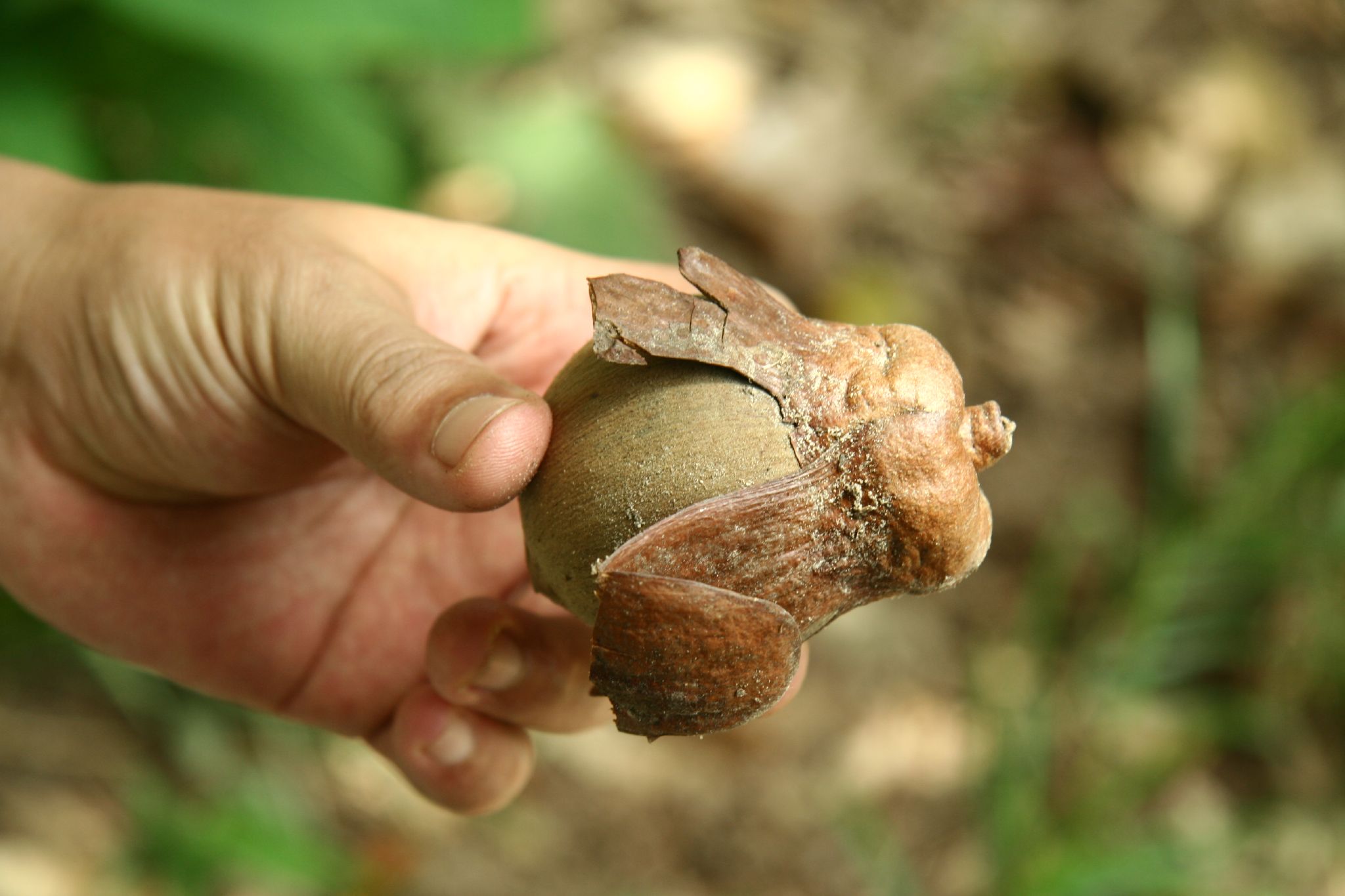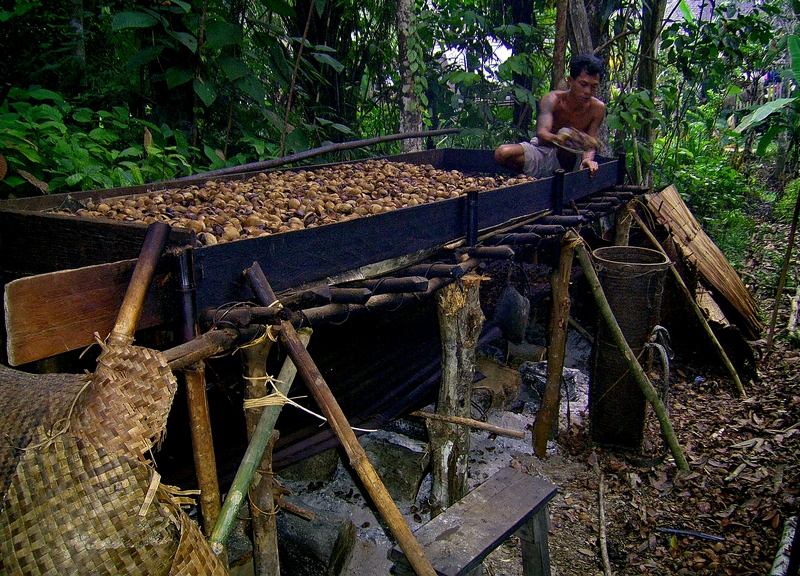Borneo tallow nut oil

Photograph by: Wakx / Original file![]()

Photograph by: Wibowo Djatmiko (Wie146) / Original file![]()
Source plants
- scientific name
- Shorea stenoptora(Dipterocarpaceae)
- general name
- Borneo Tallow Nut, Borneo Illipe
- overview
-
Shorea, a genus in the family Dipterocarpaceae, contains over 10 tree species that produce fruits from which economically useful oil can be extracted (these species are collectively referred to as “tengkawang” by local people). Thirteen species have been confirmed in Indonesia: 10 species are distributed in Kalimantan and three species in Sumatra. The fruits have been harvested from natural/semi-natural forests and plantations. Shorea stenoptera is a representative “tengkawang” species that originated in Borneo and is one of the source species from which illipe nuts can be harvested. The Borneo tallow is a tall, evergreen tree with a straight trunk, dense canopy, diameter at breast height of 70 cm, and tree height of 30 m. It grows in humus-rich soil in rarely flooded, sandy alluvium in wet, lowland tropical forests and in Kerangas forests with poorly drained podzol soil. It also grows in heath forests with acidic, sandy, and nutritionally poor (especially nitrogen-poor) soil. In natural regeneration, the seeds fall and germinate near the seed tree or are carried away during flooding and germinate in other places with similar conditions. The tree is planted in some places in Borneo. The IUCN Red List registers the species as Endangered. In Indonesia, Government Ordinance No. 7/1999 designates it as a protected species.
Product characteristics
- use
- Fallen fruits are dried and shipped and then steamed to compress-extract oil (the main constituent is glyceride of stearic acid). The oil is economically important as a vegetable oil. It has a high melting point and is solid at room temperature (35 –37 ˚C). Traditionally, it is used as an ingredient for cooking oil, illuminating oil, and medicine by local people. Industrially, it is used as a substitute for cocoa butter and shea butter. It is also used as a mixing agent for products like margarine, cheese, snacks, and chocolate. It is also used in lipsticks and suppositories, because of the oil’s nature of melting at body temperature, and in cosmetics such as skin moisturizers. Additionally, it is used as an ingredient in candles and soaps. The trunk produces a high quality timber known as light red meranti.
- area
- Malaysia, Indonesia
- overview
-
The tree starts bearing fruits after 18–25 years. A bumper year comes every five years or so. Fallen fruits are collected. Along rivers, fences made from bamboos or other materials are built to collect fruits that float down the rivers. The egg-shaped fruits have “wings” and the size, which varies depending on the species, is approximately 5 cm long and 3 cm wide and is covered with a husk (epicarp). The color is brown-black. The fruit’s fat content is 45–70%. Due to their high germination capacity, the fruits quickly decompose after absorbing moisture. A dry fruit yield of 1,138 kg/ha has been reported.
Damages to the fruits caused by insects (Lepidoptera and Coleoptera) during storage increases the content of free fatty acids, resulting in quality loss of the oil. Other reported pests include Poecilips gedeanus (Beaver) and Tirathaba spp. (Brady)
Storage of fruits, husk removals, oil extraction method
There are several husk removal methods for extracting oil: 1) make the fruits germinate in flowing water, 2) make the fruits germinate in soil, 3) steam the fruits in a kiln at 55 ˚C, and 4) mechanically break the fruits. The broken husks can be removed by hand. Removed nuts are dried in the sun for five to seven days and stored. The nuts can be dried to a water content of 7% to prevent decomposition during storage.
To extract oil, local villagers boil the fruits in a pan, put them in a rattan bag, hold the bag between logs of wood, and squeeze the logs together. The extracted oil is stored in bamboo cylinders. For industrial purposes, solvent extraction with hexane is used. Extracted oil is then purified and bleached. Post-extraction residues contain tannic acid and can be used as animal feed.

Main fatty acids contained in Borneo tallow nut oil
stearic acid 43.3% oleic acid 37.4% palmitic acid 18.0% arachidic acid 1.1% linoleic acid 0.2% An oil extraction and purification plant is located in Pontianak, western Kalimantan in Indonesia, which produces cacao butter made from cacao and illipe nut butter made from Borneo tallow nuts.
Export and import trends, demands in Japan
According to one report, in the peak years, Indonesia exported 41,000–50,000 t of the dry fruits annually. Till around 1990, Japan imported Borneo tallow nuts to extract oil, but has since then directly imported the vegetable oil instead of the fruits from which the oil is extracted.
In Indonesia, however, Commerce Minister’s Order No. 44/2012 added Borneo tallow nuts to the export prohibition list for raw materials. In response, the momentum toward processing the nuts domestically and exporting the finished products is strengthening.
Potential for forest-based business
Vegetable oil extracted from Borneo tallow nuts is economically important as a non-wood forestry product and has potential for striking the balance between forest preservation and the livelihood of local residents. Therefore, the tree is currently used as a plantation species for forest regeneration or community forest development projects. Western Kalimantan and western Java are home to Shorea stenoptera plantations, where the trees start bearing fruits after four years. While its ultimate purpose is wood use, if the nuts can be collected before the trees are felled, they will become a source of income for the local people, contributing to community development and the maintenance and regeneration of local rainforests.
Yearly fluctuation of “tengkawang” fruit production has been significant with the fruiting interval being irregular (from every a few years to 10 years). In fruit-bearing years, the nuts become the most important export for Sarawak. Recently, research done by CIFOR and other organizations found that Shorea species that bear fruits every year raise expectations for an annual, stable supply of the nuts, increasing its demand as an industrial raw material.
- references
-
- Duke J.A. 1989: Arenga pinnata (Wurum) Merr. (Arecaceae) In Handbook of Nuts, pp 30-33, CRC Press LLC
- Suzuki, E. et al. 1997: Ecology of Tengkawang Forests under Varylng Degrees of Management In West Kallmantan.
- FAO. 1992. Minor oil crops. Borneo tallow nut. (http://www.fao.org/docrep/X5043E/x5043E05.htm#Borneo tallow nut)
- 北野至亮(1984)熱帯植物要覧. ステノプテラサラソウジュ. 熱帯植物研究会編. 養賢堂.
- 渡辺弘之(1994)熱帯の非木材林産物. 熱帯林造成技術テキストNo.5. (財)国際緑化推進センター


